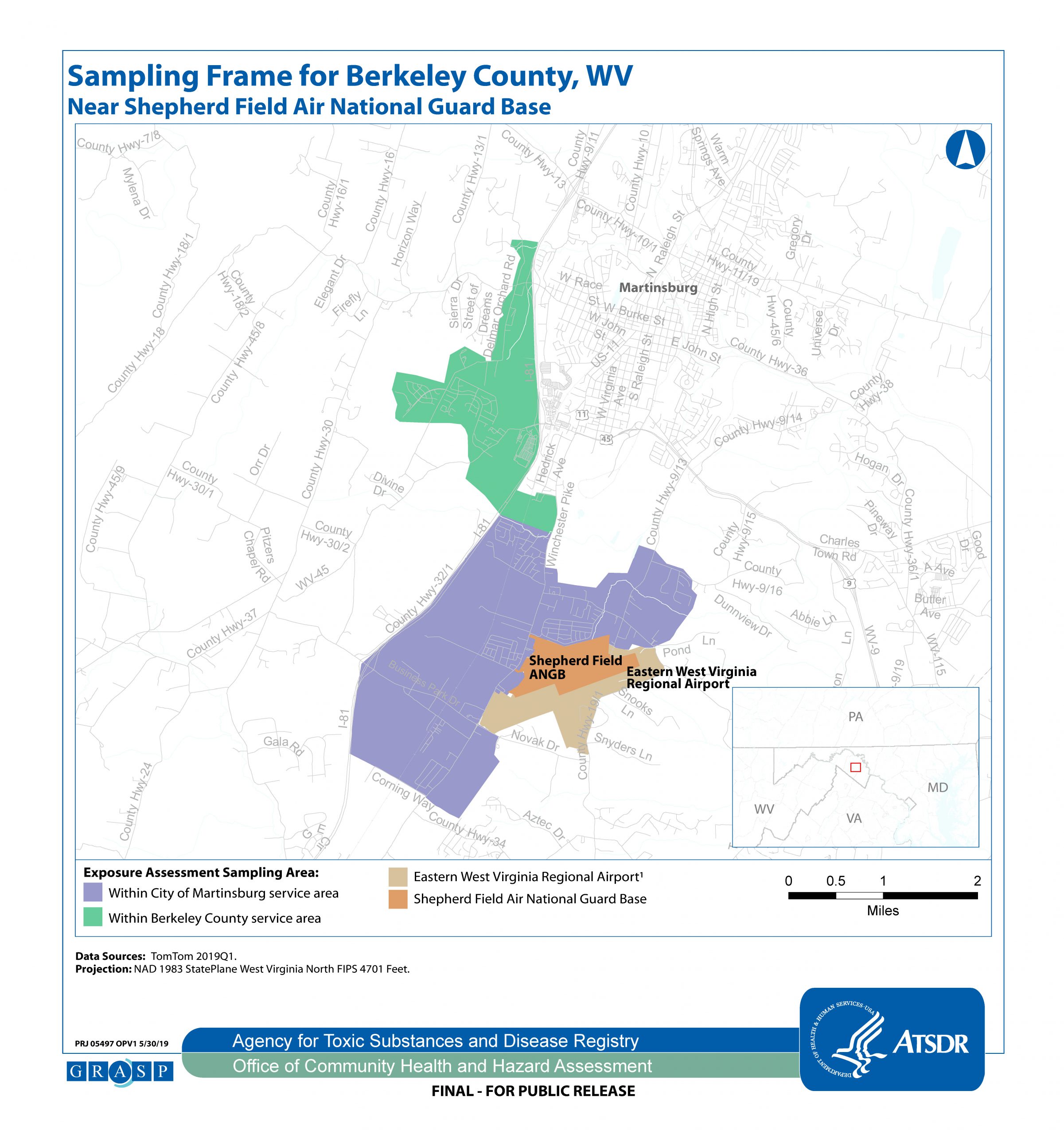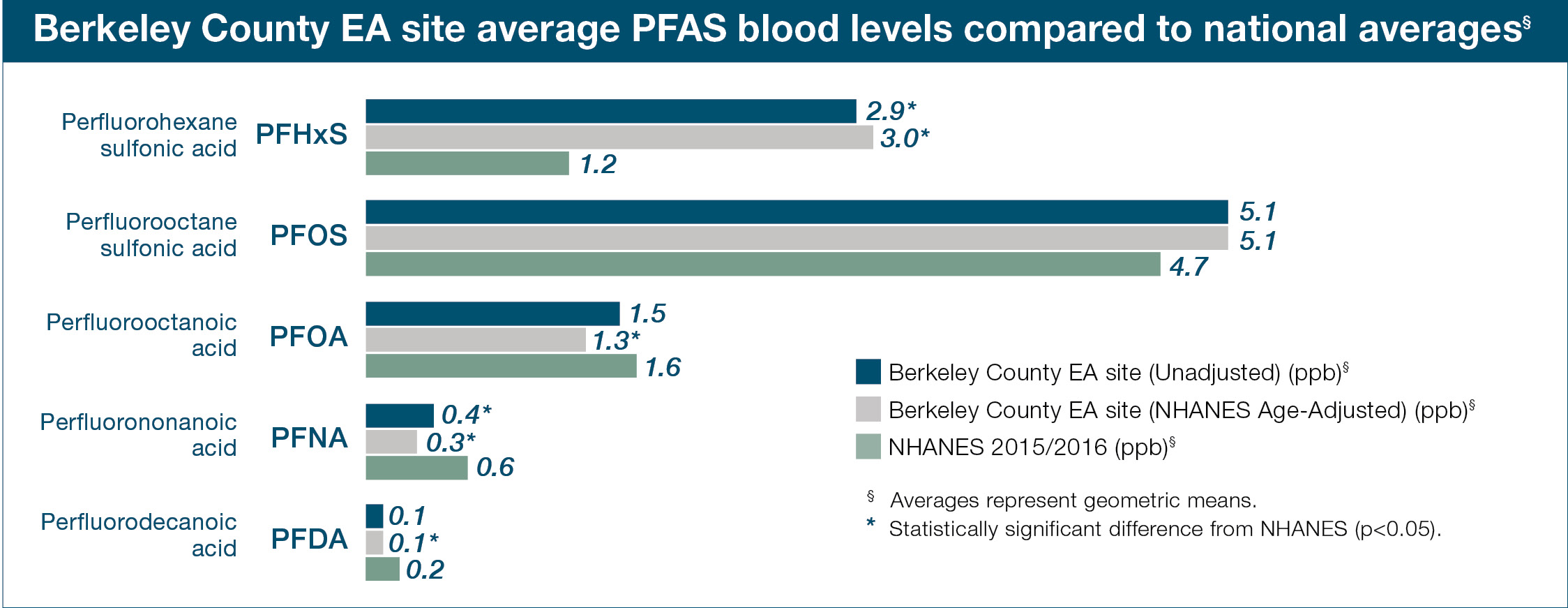Key points
- PFAS in drinking water in the Berkeley County, WV, exposure assessment (EA) site was from use of products like aqueous film forming foam (AFFF).
- Levels of PFAS (PFHxS) in participants' blood were 2.5 times higher than national levels.
- All tap water samples collected during the EA in 2019 met the EPA's health advisory for drinking water.

Background
Water test results
At this time, ATSDR does not recommend alternative water sources for community members who get their water from the City of Martinsburg or Berkeley County Public Service Water District (PSWD).
In 2019, the Centers for Disease Control and Prevention (CDC) and the Agency for Toxic Substances and Disease Registry (ATSDR) conducted an exposure assessment (EA) in and around the City of Martinsburg in Berkeley County, West Virginia, near Shepherd Field Air National Guard Base (the Base).
CDC/ATSDR sent the individual test results to participants and released summary results to the community in May 2020. The PFAS exposure assessment report was released in January 2022.
Why Berkeley County was selected
When selecting EA sites, ATSDR considered the extent of PFOA and PFOS contamination in drinking water supplies. It also considered the:
- Duration that exposure may have occurred.
- Number of potentially affected residents.
The Berkeley County EA site identified PFAS drinking water contamination from use of products such as aqueous film forming foam (AFFF). The Base previously used AFFF containing PFAS for its firefighter training, possibly as early as the 1970s.
Over time, the PFAS from the AFFF entered the ground and moved into the groundwater to offsite locations. This impacted the City of Martinsburg's Big Springs well located downgradient of the Base. The well supplies water to customers from both the City of Martinsburg and the Berkeley County PSWD.
In May 2016, the City of Martinsburg removed its Big Springs well from service. They installed a treatment system and brought the Big Springs well back online in December 2017. The City of Martinsburg now conducts routine monitoring to ensure treatment is effectively removing PFAS.
Based on the information reviewed by ATSDR, the City of Martinsburg and the Berkeley County PSWD public drinking water supplies currently meet the U.S. Environmental Protection Agency's (EPA) 2016 health advisory (HA) for PFAS in drinking water.
Sampling area

Timeline
Information session
Meeting date: 07/24/19
Recruitment begins
Letters sent following the information session
Letters sent 07/24/19
Phone calls start 07/29/19Field work/sample collection
Began: 09/24/19
Ended: 10/17/19Samples analyzed
Completed
Individual test results
Mailed 05/15/20
EA site report
Findings and recommendations released 01/20/22
Community meeting
Met 02/03/22
How testing was conducted
ATSDR invited all Berkeley County residents living near the Base to participate in the EA. To qualify, household residents must have:
- Lived within the sampling area.
- Received their drinking water from the City of Martinsburg or the Berkeley County PSWD for at least 1 year before May 19, 2016.
- Been older than three years at the time of sample collection.
- Not been anemic or had a bleeding disorder that would prevent giving a blood sample.
Households with private wells were not eligible for participation. Measuring PFAS in the blood of people from selected households allows us to estimate exposure from consumption of public drinking water for the entire community in the affected area, even those who were not tested.
Results
In May 2020, CDC/ATSDR released a report summary of the biological and environmental test results. The full report was released January 20, 2022, and a summary of the report's findings is presented below. The full report is also available.
In September and October 2019, ATSDR collected samples and other information from participants. ATSDR analyzed data from:
- 275 adults and children from 165 households.
- Questionnaires completed by all participants.
- Blood and urine samples provided by most participants.
- The serum portion of blood samples.
ATSDR sent individual results to each participant in May 2020.
Key takeaways
Levels of PFHxS in the blood of Berkeley County EA participants were 2.5 times higher than national levels. Other PFAS measured in blood (PFOS, PFOA, PFNA, and PFDA) were similar to national averages or detected too little to compare.
- Elevated blood levels of PFHxS may be linked with past drinking water contamination.
- Some demographic and lifestyle characteristics were linked with higher PFAS blood levels.
- All tap water samples collected during the EA in 2019 met EPA's HA for PFAS.
Additional testing at the site
Only one PFAS (PFBA) was detected in urine; it was detected at low concentrations.
All tap water samples collected during the EA in 2019 met the EPA's HA for PFAS in drinking water.
PFAS contamination in house dust was similar to that reported in other studies (with or without PFAS contamination).
Future direction
What was learned about PFAS levels in blood
Did you know?
Of the seven PFAS tested at the Berkeley County EA site, five PFAS were detected in more than 74% of the blood samples collected:
- PFHxS
- PFOS
- PFOA
- PFNA
- PFDA
Since 1999, the National Health and Nutrition Examination Survey (NHANES) has measured PFAS levels in blood in the U.S. population. PFAS levels are shown to be age dependent and tend to increase with age in part due to longer periods of exposure.
ATSDR adjusted blood levels of participants at the Berkeley County EA site for age for meaningful comparison to the NHANES dataset. After adjusting for the effects of age, PFHxS remained elevated compared to national levels*. Age-adjusted averages are more representative of the Berkeley County EA site community.

*ATSDR initially reported PFOS levels were above national average; after statistical analysis, this difference was not observed.
Information to protect our communities
Did you know?
PFHxS was first detected in the City of Martinsburg's Big Springs well in 2014. Since no data are available prior to 2014, we do not know if contamination began earlier. This contaminated well also supplied water to the Berkeley County PWSD.
By December 2017, the City of Martinsburg and Berkeley County PWSD drinking water met the EPA's HA for PFOA and PFOS. There were over 3 years and 5 months between the reduction of exposure via contaminated drinking water and the collection of blood samples.
Due to the long half-lives of PFAS in humans, past drinking water exposures may have contributed to participants' PFAS blood levels. Typically, participants who had greater PFHxS blood levels also had greater PFOS and PFOA blood levels. This suggests a common exposure source, like the City of Martinsburg or Berkeley County PSWD public water supply, though other sources of exposure may also have contributed.
Participants living in the Martinsburg service area had 60% higher PFHxS blood levels than those who lived in the Berkeley County PSWD service area.
Statistical findings
Both water systems used contaminated water from the Big Springs well. It was mixed with uncontaminated water from other parts of the system. It is possible that more uncontaminated water was mixed into the Berkeley County PSWD. ATSDR used statistical models to study relationships between various demographic characteristics and lifestyle variables of the tested residents. The models showed that, in general:
Blood levels of PFHxS, PFOS, and PFOA varied by age.
Blood levels in females increased by 1.5% to 2.4% for every year of age.
Blood levels of PFHxS in males decreased by 0.5% but increased for PFOS and PFOA by 0.2% for every year of age.
Males had higher blood levels of PFHxS, PFOS, and PFOA than females.
The difference between males and females was larger in younger people.
Long-time residents have higher PFHxS blood levels.
PFHxS increased by 5.3% for every additional year an adult participant lived in Berkeley County EA site.
There is limited data on the following:
Participants donating blood at least once a year had 31% lower blood levels of PFOS than participants who never reported donating blood.
Those with histories of kidney disease had PFHxS blood levels that were 39% lower than those who did not.
Exposure in children
Due to the small number of child participants, associations between blood PFAS levels and many variables could not be examined. Any observations in children are noted in the report, but in most cases ATSDR was not able to draw strong conclusions. ATSDR will gather the data from children across all EA sites and provide a detailed analysis. A report will be available to all communities.
What these results mean for the community
Water quality
Based on recent PFAS test results from the City of Martinsburg and Berkeley County PSWD, ATSDR does not recommend an alternate source of drinking water at this time.
This EA has shown that past exposures to PFAS in drinking water have impacted levels of PFAS in humans. PFAS are eliminated from the body over a long period of time. This allowed ATSDR to measure PFAS even though exposures through drinking water were lowered, years ago. PFAS found in blood or urine means exposure has occurred. The presence of PFAS in blood or urine does not tell us how, where, when, or for how long a person was exposed to PFAS. Exposure to PFAS does not mean adverse health effects will result, either now or in the future.
Although the exposure contribution from PFAS in drinking water at the Berkeley County EA site has been mitigated, there are actions community members and city and county officials can take to further reduce exposures to PFAS and protect public health.
What more can be done
Community
For information on water quality, become familiar with Consumer Confidence Reports.
Private well owners living in the area affected by PFAS should consider having their wells tested for PFAS if testing has not been conducted before. NSF International, the global health organization, developed a test method to verify a water filter's ability to reduce PFOA and PFOS to below the health advisory levels set by the EPA.
To find NSF International-approved devices, go to the bottom of the Search for NSF Certified Drinking Water Treatment Units page. Then check the boxes for PFOA Reduction and PFOS Reduction.
Nursing mothers should continue breastfeeding. Based on current science, the known benefits of breastfeeding outweigh the risks for infants exposed to PFAS in breast milk.
Eliminate or decrease potential exposure to PFAS when possible. This pertains to consumer products such as stain-resistant products and food packaging materials.
Pay attention to advisories about food consumption, such as local fish advisories.
Discuss any health concerns or symptoms with your health care provider. Share results of PFAS blood testing with your health care provider and make them aware of ATSDR resources for clinicians.
Follow the advice of your health care provider and the recommendations for checkups, vaccinations, prenatal care, and health screening tests.
For your child, follow the advice of their health care provider and the recommendations for well child checkups, vaccinations, and health screening tests. Consult My Health Finder to help identify those vaccinations and tests. For more information about environmental exposures and children's health, contact the Pediatric Environmental Health Specialty Units, a nationwide network of experts in reproductive and children's environmental health.
What the City of Martinsburg and Berkeley County can do
Operators of public water systems should continue to monitor concentrations of PFAS in drinking water delivered to the Berkeley County community. This will ensure that concentrations of PFAS remain below the EPA's HA or other applicable guidelines for specific PFAS in drinking water.
Properly maintain all treatment systems to remove PFAS from the municipal drinking water in City of Martinsburg and Berkeley County PSWD. This will help ensure that PFAS concentrations remain below the EPA's HA in drinking water.
Share results of PFAS monitoring for drinking water with community members through appropriate communication channels for the City of Martinsburg and Berkeley County PSWD.
Resources
- PFAS Exposure Assessment, Berkeley County, WV: Fact Sheet
- PFAS Exposure Assessment, Berkeley County, WV: Community-Level Summary Results Fact Sheet
- PFAS Exposure Assessment, Berkeley County, WV: Report
- PFAS Exposure Assessment Martinsburg, Berkeley County, WV: Report Appendix
- PFAS Exposure Assessment, Berkeley County, WV: Report Consumer Summary

